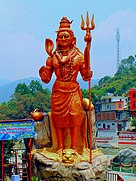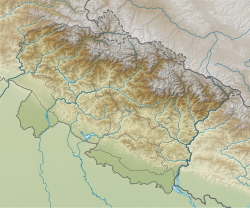Bageshwar
Bageshwar | |
|---|---|
Town | |
|
Clockwise from top: View of Bageshwar from Chandika Temple,Sarju Ghat,Lord ShivaStatue, Suspension Bridge on the Sarju andBagnath Temple | |
| Coordinates:29°50′17″N79°46′16″E/ 29.838°N 79.771°E | |
| Country | |
| State | Uttarakhand |
| Division | Kumaon |
| District | Bageshwar |
| Government | |
| • Type | Municipality |
| • Body | Nagar Palika Parishad Bageshwar[1] |
| Area | |
| • Total | 5.50 km2(2.12 sq mi) |
| Elevation | 935 m (3,068 ft) |
| Population | |
| • Total | 9,079 |
| • Density | 1,700/km2(4,300/sq mi) |
| Languages | |
| • Official | Hindi Sanskrit |
| • Native | Kumaoni |
| Time zone | UTC+5:30(IST) |
| PIN | |
| Vehicle registration | UK-02 |
| Website | uk |
Bageshwar(Kumaoni:Bāgshyār) is a town and amunicipal boardinBageshwar districtin the state ofUttarakhand,India.It is located at a distance of 470 km from the National CapitalNew Delhiand 332 km from the State CapitalDehradun.[2]Bageshwar is known for its scenic environment,glaciers,riversandtemples.It is also the administrative headquarters ofBageshwar district.[3]
Situated on the confluence ofSaryuandGomati rivers,[4][5]Bageshwar is surrounded by the mountains of Bhileshwar and Nileshwar to its east and west, the Suraj Kund in the north, and Agni Kund in the south. Bageshwar was a major trade mart betweenTibetandKumaun,and was frequented by theBhotiatraders, who bartered Tibetan wares,wool,saltandBoraxin exchange for carpets and other local produces in Bageshwar.[6]The trade routes were, however, closed after theIndo-China War of 1962.
The city is of great religious, historic and political significance. Bageshwar is mentioned in variousPuranas,where it has been associated withShiva.[7]The Uttrayani fair held annually in Bageshwar used to be visited by approx 15,000 people in the early twentieth century, and was the largest fair ofKumaon division.[8]The fair became the epicenter of theCoolie Begar Movementin January 1921.[9]The city of Bageshwar gets its name from theBagnath Temple.[10]HindiandSanskritare the official Languages howeverKumaoniis spoken by a large number of people.
History[edit]
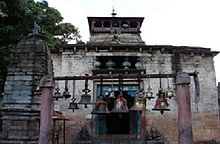
The city andBagnath Templefind mention in the Manaskhand ofShiva Purana,where it is written that the temple and its surrounding city was built byChandeesh,a servant of the Hindu deityShiva.[11][12]According to another Hindu Legend,Sage MarkandeyaworshippedLord Shivahere.[13][14]Lord Shiva blessed sage Markandeya by visiting here in the form of aTiger.[13][14]
Bageshwar has historically been a part ofKumaon Kingdom.Bageshwar was located adjacent toKartikeypura,the then capital ofKatyuri Kingsthat ruled over Kumaon in the 7th century.[15]After death ofBirdeothe last king of united katyuri kingdom. the kingdom disintegrated in the 13th century giving rise to 8 different princely states. Bageshwar region remained under the rule of Baijnath Katyurs descendants of Katyuri kings, till 1565 until king Balo Kalyan Chand ofAlmoraannexed the region toKumaon.[16][17]In the 10th century, the Chand dynasty was established by Som Chand. He displaced the Katyuri Kings, called his state Kurmanchal and established its capital inChampawatin Kali Kumaon.[18][19][20]In 1568,[21]Kalyan Chand established a permanent capital at Khagmara[22]and called itAlmora.[23][24][25]
In 1791, theGorkhasofNepalwhile expanding their kingdom westwards acrossKali River,invaded and overranAlmora,[26]the seat of the Kumaon Kingdom and other parts of Kumaon including Bageshwar. The Gorkhas were defeated by theEast India Company[27]inAnglo-Nepalese Warin 1814[28][29][30]and were forced to cede Kumaon to the British as part of theTreaty of Sugauliin 1816.[31]: 594 [32]
The Kumaon region was joined with the eastern half of theGarhwalregion and was governed as a chief-commissionership, also known as the Kumaon Province, on the non-regulation system.[33]According to Atkinson's The Himalayan Gazetteer, Bageshwar had a population of 500 in 1886.[34]In 1891, the division was composed of the three districts of Kumaon,Garhwaland theTarai;but the two districts of Kumaon and the Tarai were subsequently redistributed and renamed after their headquarters,NainitalandAlmora.
Before theFirst World War,theBritish Governmentdid a Survey for a rail link connecting Bageshwar withTanakpurin 1902.[35][36]However, the project was stalled by British due to TheWorld War.The Surveys restarted in the 1980s afterIndira Gandhivisited Bageshwar. The first motor road arrived in Bageshwar in 1952 fromAlmoraviaGarur.Bus services started operating on the Bageshwar-Kapkotmotorway in 1955–56. After the1962 India-China War,an important strategic road connecting Bageshwar withPithoragarhwas completed in 1965.
In the early phase of its urban development, the central township of Bageshwar was a group of 9 small mutually tangled group of villages which had 3 uninhabited and 6 occupied villages. The Bageshwar State village was formed in 1948 by joining these villages. Bageshwar was declared a town in 1955, under the UP Town Area Act of 1914, and the firstTown area committeewas constituted in 1957.[37]Bageshwar received the status of anotified area committeein 1962 andmunicipal Councilin 1968. The pumping water supply scheme was introduced in Bageshwar town in 1975.[37]The estimate for water supply was prepared in 1968-69 for a designed population of 6000 persons for the year 1997.
In the early twentieth century,dispensary(1906) andPost Office(1909) were established in Bageshwar. A public school started in 1926, which was made junior high school in 1933. After independence by several attempts from local residents, a private high school was opened in 1949 in memory of Victor Mohan Joshi, which became an Inter College in 1967. The first women's primary school started in the 1950s and women's public high school started in 1975. A new Government Degree College was inaugurated in 1974 by the then Chief MinisterHemwati Nandan Bahuguna.
AfterIndependence of Indiain 1947, Bageshwar was a part of theAlmora District.[38]Bageshwar had a population of 1740 people according to the1951 Census.It was part of theKandadevelopment block, that was later converted into Bageshwar development block. On 15 September 1997 theBageshwar districtwas carved out of Almora district[10]by thenUttar PradeshChief MinisterMayawatiand Bageshwar became its Headquarter. On 9 November 2000, Bageshwar came in theUttarakhandState that was created from the Himalayan and adjoining northwestern districts ofUttar Pradesh.[39]
Geography and Climate[edit]
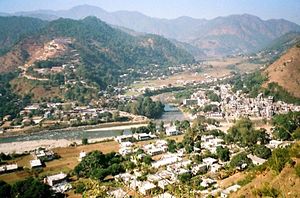
Bageshwar is located at29°29′N79°27′E/ 29.49°N 79.45°E[40]in Bageshwar District in Uttarakhand. It is situated 470 km North-East of the National CapitalNew Delhiand 332 km South-East of the State CapitalDehradun.It lies in theKumaon division[41]and is situated 153 km North-East ofNainital,the Headquarters of Kumaon. Bageshwar is situated in a valley of the Kumaon Hills of the Central Himalaya range.[42]It has an average elevation of 934metres(3,064feet). The chief trees are theChir Pine,Himalayan Cypress,Pindrow Fir,alder,salor iron-wood, and saindan. Limestone, sandstone, slate, gneiss and granite constitute the principal geological formations.
Its climate is characterized by relatively high temperatures and evenly distributed precipitation throughout the year. In summer, Bageshwar is largely under the influence of moist, maritime airflow from the western side of the subtropical anticyclonic cells over low-latitude ocean waters. Temperatures are high and can lead to warm, oppressive nights. Summers are usually somewhat wetter than winters, with much of the rainfall coming from convectional thunderstorm activity; tropical cyclones also enhance warm-season rainfall in some regions. The coldest month is usually quite mild, although frosts are not uncommon, and winter precipitation is derived primarily from frontal cyclones along the polar front. The Köppen Climate Classification subtype for this climate is "Cfa" (Humid Subtropical Climate).
The average temperature for the year in Bageshwar is 20.4 °C (68.8 °F). The warmest month, on average, is June with an average temperature of 27.3 °C (81.2 °F). The highest temperature ever recorded was 38 °C, recorded on 5 June 2017.[43]The coolest month on average is January, with an average temperature of 11 °C (51.8 °F). The average amount of precipitation for the year in Bageshwar is 48.1 "(1221.7 mm). The month with the most precipitation on average is July with 13.0" (330.2 mm) of precipitation. The month with the least precipitation on average is November with an average of 0.2 "(5.1 mm). There are an average of 63.6 days of precipitation, with the most precipitation occurring in August with 15.3 days and the least precipitation occurring in November with 0.8 days.
| Climate data for Bageshwar, India | |||||||||||||
|---|---|---|---|---|---|---|---|---|---|---|---|---|---|
| Month | Jan | Feb | Mar | Apr | May | Jun | Jul | Aug | Sep | Oct | Nov | Dec | Year |
| Mean daily maximum °C (°F) | 17.2 (63.0) |
19.5 (67.1) |
25.0 (77.0) |
30.7 (87.3) |
33.7 (92.7) |
32.9 (91.2) |
29.4 (84.9) |
28.9 (84.0) |
28.7 (83.7) |
27.4 (81.3) |
23.6 (74.5) |
19.1 (66.4) |
26.4 (79.5) |
| Daily mean °C (°F) | 11.0 (51.8) |
13.1 (55.6) |
18.1 (64.6) |
23.6 (74.5) |
26.8 (80.2) |
27.4 (81.3) |
25.4 (77.7) |
26.8 (80.2) |
24.2 (75.6) |
21.3 (70.3) |
16.8 (62.2) |
12.7 (54.9) |
20.5 (68.9) |
| Mean daily minimum °C (°F) | 4.9 (40.8) |
6.7 (44.1) |
11.2 (52.2) |
16.5 (61.7) |
19.8 (67.6) |
21.8 (71.2) |
21.5 (70.7) |
21.3 (70.3) |
19.8 (67.6) |
15.2 (59.4) |
10.0 (50.0) |
6.3 (43.3) |
14.6 (58.3) |
| Averageprecipitationmm (inches) | 32.9 (1.30) |
35.1 (1.38) |
30.1 (1.19) |
24.4 (0.96) |
43.7 (1.72) |
157.0 (6.18) |
328.9 (12.95) |
328.2 (12.92) |
178.4 (7.02) |
42.5 (1.67) |
6.0 (0.24) |
13.6 (0.54) |
1,220.8 (48.06) |
| Average precipitation days | 2.7 | 2.9 | 2.8 | 2.1 | 3.0 | 8.1 | 14.2 | 15.3 | 8.3 | 2.3 | 0.8 | 1.1 | 63.6 |
| Mean dailysunshine hours | 10.9 | 11.6 | 12.4 | 13.3 | 14.1 | 14.5 | 14.3 | 13.6 | 12.7 | 11.8 | 11.1 | 10.7 | 12.6 |
| Source: Weatherbase[44] | |||||||||||||
Demographics[edit]
| Year | Pop. | ±% |
|---|---|---|
| 1951 | 1,740 | — |
| 1961 | 2,189 | +25.8% |
| 1971 | 4,314 | +97.1% |
| 1981 | 4,225 | −2.1% |
| 1991 | 5,772 | +36.6% |
| 2001 | 7,803 | +35.2% |
| 2011 | 9,079 | +16.4% |
According to the2011 census of India,Bageshwar has a population of 9,079 comprising 4,711 males and 4,368 females.[47]Males constitute approximately 55% of the population and females 45%. The sex ratio of bageshwar is 1090 women per 1000 men,[49]higher than the national Average of 940 women per 1000 men.[50]The City ranked 4th in Uttarakhand in terms of Sex Ratio.[51]Bageshwar has an averageliteracy rateof 80%, higher than thenational averageof 72.1%; with 84% of the males and 76% of females literate.[48]11% of the population is under 6 years of age.[48]2,219 people belong to theScheduled Casteswhile the population of people belonging toScheduled Tribesis 1,085.[48]Bageshwar had a population of 7803 according to 2001 Census[52]and 5,772 according to the 1991 census.[47]
Out of total population, 2,771 were engaged in work or business activity. Of this 2,236 were males while 535 were females.[48]In census survey, worker is defined as person who does business, job, service, and cultivator and labour activity.[53]Of total 2771 working population, 78.06% were engaged in Main Work while 21.94% of total workers were engaged in Marginal Work.[54]
Hinduismis practiced by 93.34% of total population and is the religion of the Majority in Bageshwar.[45]Other Religions includeIslam(5.93%),Sikhism(0.25%),Christianity(0.26%),Buddhism(0.01%) andJainism(0.02%).[45]
Kumaoniis the majority first language, althoughHindiandSanskrit[55]are the official languages of the state.Englishis also spoken by a small number of people.
Government and politics[edit]
TheBageshwar Assembly seatis reserved for a person belonging to theScheduled Castes.Chandan Ram DasfromBharatiya Janata Partyis the presentMLAOF Bageshwar.[56]Bageshwar is a "Nagar Palika Parishad" (Municipal Council) city in district of Bageshwar, Uttarakhand.[57]The Bageshwar city is divided into 7 wards,[58]for which elections are held every 5 years.[59]The Bageshwar Nagar Palika Parishad has population of 9,079 of which 4,711 are males while 4,368 are females as per report released by Census India 2011. Suresh khetwal fromIndependent candidateis the Mayor of Bageshwar.[60]Bageshwar Nagar Palika Parishad has total administration over 2,054 houses to which it supplies basic amenities like water and sewerage. It is also authorized to build roads within Nagar Palika Parishad limits and impose taxes on properties coming under its jurisdiction. The Uttarakhand Power Corporation Ltd. (UPCL) is responsible for supply of electricity in the city. Uttarakhand Jal Vidyut Nigam Ltd. generates electricity from the 8.5 MW electric sub-station at Bageshwar. The Notified Area Committee, Bageshwar is responsible for approval of building plans after getting no objection certificate from various departments like Jal Nigam, PWD, Electricity Board and Health Department etc.
Economy[edit]

Bageshwar's largest economic sectors includeagriculture,trade,transportation,municipal,tourismand resource extraction. Copper Utensils and Carpets were listed as the two most important industrial commodities produced in Bageshwar in the2011 Census of India.[61]Large portions of the local economy of Bageshwar depend on its geographical location and surroundingnatural resources.Per capita incomeof Bageshwar wasRs22709 in 2015.[62]Bageshwar is a major tourist destination and acts as a starting point for many trekking routes notably being toPindari,Kafniand Sunderdhunga Glacier. It also lies along the path toKailash-Mansarovarpilgrimage.[63]
Bageshwar has traditionally been a major gateway for trade withCentral AsiaandTibet.It carried on a brisk trade betweenCentral AsiaandKumaon,and was described inThe Imperial Gazetteer of Indiaas "one of the main outlets for theTibetantraffic ".[64]TheBhotiyatraders travelled to Tibet and sold their wares at major fairs in Bageshwar, Gyanema andGartok.[65]The city was once rich inagricultureandanimal husbandry.Besides growing crops, people were mainly engaged in sheep rearing. However, agriculture and sheep rearing in Bageshwar have suffered as villagers, who are increasingly joining armed forces, after retirement are settling down in Bageshwar town instead of their native villages.[10]
The traditional Uttarayani festival organised since centuries on the banks of theSarjuandGomati riverswas the main place where woollen outfits made by Saukas ofMunsiyariwere brought form higher valleys for ages, thus strengthening trade links between the two communities.[17]
As of 2006, Bageshwar had a total of 6 Health Care units including four Hospitals (TwoAllopathic,oneAyurvediand oneHomeopathic), one Maternity & Child welfare centre and one Community Health Centre.[66]Bageshwar has a total of Five Nationalized Bank's, Two Post Offices, One Telegraph Office, 80 PCO'S and 1844 Telephone Connections.[37]Mobile Communication services are provided by Private companies likeVodafone,Airtel,Idea,Relianceetc.
Culture[edit]

Many classical dance forms and folk art are practised in the city. Some well-known dances include Hurkiya Baul,[67]Jhora-Chanchri andChholiya.[68]Music is an integral part of the Kumaoni culture. Popular types of folk songs include Mangal and Nyoli.[69]These folk songs are played on instruments includingdhol,damau, turri,ransingha,dholki,daur,thali,bhankora,mandan andmashakbaja.Music is also used as a medium through which the gods are invoked.Jagaris a form of spirit worship in which the singer, orJagariya,sings a ballad of the gods, with allusions to great epics, likeMahabharatandRamayana,that describe the adventures and exploits of the god being invoked.Ramleelahas been staged annually during the autumn festival ofNavratrisince 1948 in Bageshwar.[70]
The primary food of Bageshwar is vegetables with wheat being a staple. A distinctive characteristic of Kumaoni cuisine is the sparing use of tomatoes, milk, and milk based products. Coarse grain with high fibre content is very common in Kumaon due to the harsh terrain. Another crop which is associated with Kumaon isBuckwheat(locally calledKotuorKuttu). Generally, eitherDesi GheeorMustard oilis used for the purpose of cooking food. Simple recipes are made interesting with the use of hash seedsJakhyaas spice.Bal Mithaiis a popular fudge-like sweet. Other local dishes include Dubuk, Chains, Kap, Chutkani, Sei, andgulgula.A regional variation ofKadhicalledJhoiorJholiis also popular.[71]
Temples[edit]

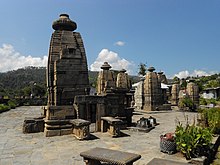

Hinduismis practiced by 93.34% and is the religion of the Majority in Bageshwar[45]therefore Various Temples are situated in Bageshwar.[72]the major one being:
At the junction of the rivers,GomatiandSarjustands a large temple with its conical tower. Here is the shrine of Bageswar or Vyagreswar, the, "Tiger Lord", an epithet of Lord Siva. This temple was erected by the Kumaun king, Laxmi Chand, about 1450 A.D.,[73]but there is a Sanskrit inscription there of a far earlier date. The temple is flooded with devotees on the annual occasion of Shivratri. This place has a cluster of temples. Prominent among these temples are the Bairav temple, Dattatrey Maharaj, Ganga Mai temple, Hanuman temple, Durga temple, Kalika temple, Thingal Bhirav temple, Panchnam Junakhara and the Vaneshwar temple.
Baijnath Temple is located on the left bank of theGomti river.This is a shiv temple which was built by a Brahmin widow.[74]
- Chandika Temple
A temple dedicated to Goddess Chandika stands at a distance of about half a kilometre from Bageshwar. Every year, the temple bustles with activity as the devout congregate here to offer pujas to the deity during the Navratras.[citation needed]
- Sriharu Temple
Another important temple, the Sriharu temple, is situated at a distance of about 5 km from Bageshwer. The devotees believe that prayers for wish fulfilment here never go in vain. Every year, a large fair is organised on the Vijya Dashmi day following the Navratras.
- Gauri Udiyar
This is situated 8 km from Bageshwer. A large cave, measuring 20 m x 95 m is situated here, which houses the idols of Lord Shiva.
Transport[edit]

Pantnagar Airport,located inPantnagaris the primary Airport serving entireKumaonRegion. The Government is planning to developNaini Saini AirportinPithoragarh[75]which once developed will be much nearer.Indira Gandhi International Airport,located inDelhiis the nearest international Airport.
Kathgodam railway stationis the nearest railway station. Kathgodam is the last terminus of the broad gauge line of North East Railways that connectsKumaonwithDelhi,Dehradun,andHowrah.A new Railway line connecting Bageshwar withTanakpurhas been a long-standing demand of the people of the region.[76][77][78]the tanakpur-Bageshwar rail link was first planned byBritishin 1902.[35]However the project was stalled by Railway ministry in 2016[35]citing the commercial viability of the rail line.[79]There have also been speculations about another railway line, that would connect Bageshwar toChaukhutiaviaGarur.[80]

Bageshwar is well connected by motorable roads with major destinations of Uttarakhand state and northern India. The major roads passing through Bageshwar includeNH 109K,NH 309A,Bareilly-Bageshwar Highway,[81]and the Bageshwar-Someshwar-Dwarahatroad.Uttarakhand Transport Corporationruns Buses from Bageshwar bus station toDelhi,Dehradun,BareillyandAlmora;[82]while K.M.O.U (Kumaon Motor Owner's Union)[83]runs 55 buses on various routes toHaldwani,Almora,Takula,Berinag,Pithoragarh,DidihatandGangolihat.[84]Taxis and Private Buses, mostly run by K.M.O.U, connect Bageshwar to other major destinations of Kumaon region.[85]A Sub Regional Transport Office is located in Bageshwar[86]where Vehicles are registered by the number UK-02.[87]
A new bus station was inaugurated on 19 Feb 2020.[88]The Bageshwar roadways bus station, located in Bilona, was constructed over a period of two years at an estimated cost of INR Two Crore.[89]
Education[edit]
There are mainly government-run, private unaided (no government help), and private aided schools in the city. The language of instruction in the schools is eitherEnglishorHindi.The main school affiliations areCBSE,CISCEor UBSE, the state syllabus defined by the Department of Education of theGovernment of Uttarakhand.There are Eleven junior basic schools, three senior basic schools, two higher secondary schools and one post-graduate college to serve the needs of the population.[66]The teacher-student ratio in Bageshwar is 1:47.[37]Bageshwar has an averageliteracy rateof 80%, with 84% of the males and 76% of females literate.[48]
The first public school in Bageshwar was started in 1926, which was made junior high school in 1933. Another private high school was opened in 1949 in memory of Victor Mohan Joshi, which became an Inter College in 1967. The first women's primary school started in the 1950s and women's public high school started in 1975. A new Government Degree College was inaugurated in 1974 by the then Chief Minister Hemwati Nandan Bahuguna.
Kumaon Kesari Pandit Badridutt Pandey Government PG College is located here.
See also[edit]
External links[edit]
References[edit]
- ^"Bageshwar Municipality".18 June 2024.
- ^Indusnettechnologies, Goutam Pal, Dipak K S, SWD."Location: District of Bageshwar, Uttarakhand, India".bageshwar.nic.in.Retrieved3 August2016.
{{cite web}}:CS1 maint: multiple names: authors list (link) - ^"Bageshwar PinCode".citypincode.in. Archived fromthe originalon 8 December 2015.Retrieved17 March2014.
- ^Dehradun, NIC, Uttarakhand State Unit."District of Almora, Uttarakhand, India".almora.nic.in.Retrieved9 September2016.
{{cite web}}:CS1 maint: multiple names: authors list (link) - ^"नमामी सरयू योजना शुरू करे सरकार 14430986".Retrieved3 August2016.
- ^Bageshwar, The Imperial Gazetter of India, 1909
- ^"Uttarayani fest to bring Kumaon, Garhwal together".The Times of India.Almora.TNN. 3 January 2015.Retrieved7 July2017.
- ^Walton, H. G. (1911).Almora: A Gazetter.Allahabad: The Government Press, United Provinces. p. Appendix XXIV.
- ^"Struggle against 'kuli beggar' was launched on Uttarayani".The Tribune.Pithoragarh.14 January 2014.Retrieved7 July2017.
- ^abc"development gains elude kumaon's holy place".Retrieved3 August2016.
- ^"बागेश्वर में पार्वती के संग विराजते हैं भोलेनाथ".Amar Ujala Bureau(in Hindi). Bageshwar:Amar Ujala.22 February 2017.Retrieved24 May2017.
- ^"शिव के गण चंडीश ने बसाया था इस नगर को, यहां है बागनाथ मंदिर".livehindustan.com(in Hindi).Hindustan.23 February 2017.Retrieved24 May2017.
- ^ab"बाघ और गाय बनकर इस संगम पर घूमते थे भगवान शिव और पार्वती".Dehradun:Amar Ujala.30 May 2016.Retrieved15 October2016.
- ^abNegi, Sunil (18 May 2017)."कत्यूर व चंद शासकों के काल में बनी ऐतिहासिक इमारतें हैं उपेक्षित".JNN(in Hindi). Bageshwar: Dainik Jagran.Retrieved24 May2017.
- ^Omacanda Hāṇḍā (2002).History of Uttaranchal.Indus Publishing. pp. 63–.ISBN978-81-7387-134-4.Retrieved22 July2012.
- ^Hāṇḍā, Omacanda, 1936- (2002).History of Uttaranchal.Indus Pub. Co.OCLC604045165.
{{cite book}}:CS1 maint: multiple names: authors list (link) CS1 maint: numeric names: authors list (link) - ^ab"Home to ancient Katyuri culture".Retrieved4 August2016.
- ^Budhwar, Kusum (2010).Where Gods Dwell: Central Himalayan Folktales and Legends.Penguin Books India.ISBN9780143066026.
- ^Singh, Kumar Suresh; India, Anthropological Survey of.People of India.Anthropological Survey of India. p. 35.ISBN9788173041143.
- ^Handa, Madhu Jain By-O. C. (July 2009).Art & Architecture of Uttarakhand.Pentagon Press.ISBN9788182744172.
- ^Trivedi, Vijaya R. (1995).Autonomy of Uttarakhand.Mohit Publications. p. 33.ISBN9788174450081.
- ^Sen, Siba Pada (1971).The Sino-Indian Border Question: A Historical Review.Institute of Historical Studies. p. 68.Retrieved8 September2016.
- ^Sharma, Man Mohan.Through the valley of gods: travels in the central Himalayas.Vision Books. p. 99.
- ^Bhattacherje, S. B. (May 2009).Encyclopaedia of Indian Events & Dates.Sterling Publishers Pvt. Ltd. p. 55.ISBN9788120740747.
- ^Omacanda Hāṇḍā (2002).History of Uttaranchal.Indus Publishing. pp. 71–.ISBN978-81-7387-134-4.Retrieved22 July2012.
- ^Hamilton, Francis; Buchanan, Francis Hamilton (1819).An Account of the Kingdom of Nepal: And of the Territories Annexed to this Dominion by the House of Gorkha.A. Constable.Retrieved2 September2016.
The name Rajapur is also mentioned over a number of ancient copper plates.
- ^Lamb, Alastair (1986).British India and Tibet, 1766-1910(2nd, rev. ed.). London: Routledge & Kegan Paul.ISBN0710208723.
- ^Cross, John Pemble; foreword by J.P. (2008).Britain's Gurkha War: the invasion of Nepal, 1814-16([Rev. ed.] ed.). London: Frontline.ISBN978-1-84832-520-3.
{{cite book}}:CS1 maint: multiple names: authors list (link) - ^Naravane, M.S. (2006).Battles of the honourable East India Company: making of the Raj.New Delhi: A. P. H. Pub. Corp.ISBN978-81-313-0034-3.
- ^Gould, Tony (2000).Imperial warriors: Britain and the Gurkhas.London: Granta Books.ISBN1-86207-365-1.
- ^Martin, Robert Montgomery.The History of the Indian Empire.Mayur Publications.
- ^Summary of the operations in India: with their results: from 30 April 1814 to 31 Jan. 1823.Marquis of Hastings. 1824.
- ^Robert Montgomery Martin,History of the Possessions of the Honourable East India Company,Volume 1, pg. 107
- ^Atkinson, Edwin Thomas (1973).The Himalayan gazetteer.Cosmo Publications.Retrieved28 August2016.
- ^abc"Rail ministry stalls Tanakpur-Bageshwar link project - Times of India".Retrieved4 August2016.
- ^"टनकपुर-बागेश्वर रेल लाइन का 1902 में हुआ था आगाज!".hindi.pradesh18.com.Archived fromthe originalon 18 September 2016.Retrieved9 September2016.
- ^abcdPerspective Plan of Bageshwar District-2021(PDF).Government of Uttarakhand. Archived fromthe original(PDF)on 11 September 2016.Retrieved29 August2016.
- ^Times World Atlas,1967 Edition, Plate 30.
- ^"About Us".Government of Uttarakhand.Retrieved17 July2012.
- ^Falling Rain Genomics, Inc. - Bageshwar
- ^Kumaon Himalaya.Shree Almora Book Depot.ISBN9788190020992.
- ^Illustrated Atlas of the Himalaya.India Research Press. 2006.ISBN9788183860376.
- ^"सोमवार को सबसे गर्म रही बागेश्वर घाटी".Haldwani Bureau(in Hindi). Bageshwar: Amar Ujala. 5 June 2017.Retrieved24 June2017.
- ^"Bageshwar, India Travel Weather Averages (Weatherbase)".Weatherbase.
- ^abcd"Bageshwar District Religion Data - Census 2011".www.census2011.co.in.Retrieved5 August2016.
- ^Gopi, K.N (1978).Process of urban fringe development: A model.Concept Publishing Company.Retrieved6 August2013.
- ^abc"Uttarakhand (India): Districts, Cities, Towns and Outgrowth Wards - Population Statistics in Maps and Charts".www.citypopulation.de.
- ^abcdef2011 census, BAGESHWAR(PDF).Retrieved4 August2016.
- ^"bageshwar-district-glance".Retrieved5 August2016.
- ^"लिंगानुपात की स्थिति चिंताजनक- Amarujala".Retrieved5 August2016.
- ^"Uttarakhand: Sex Ratio as per Census 2011".15 February 2014.Retrieved5 August2016.
- ^"Census of India 2001: Data from the 2001 Census, including cities, villages and towns (Provisional)".Census Commission of India. Archived fromthe originalon 16 June 2004.Retrieved1 November2008.
- ^"Worker (Census Definition) - Arthapedia".www.arthapedia.in.Retrieved5 August2016.
- ^"Bageshwar City Population Census 2011 - Uttarakhand".www.census2011.co.in.Retrieved5 August2016.
- ^Trivedi, Anupam (19 January 2010)."Sanskrit is second official language in Uttarakhand".Hindustan Times.Archived fromthe originalon 1 February 2012.Retrieved29 July2012.
- ^Election Results 2012, Uttarakhand State.pdf(PDF).Retrieved4 August2016.
- ^"Panchayats, Municipalities and Corporations in Bageshwar District".IndiaStudyChannel.com.Retrieved5 August2016.
- ^"Nagar Palika Parisad Bageshwar".Retrieved16 June2017.
- ^"Bageshwar City Population Census 2011 - Uttarakhand".www.census2011.co.in.Retrieved5 August2016.
- ^"Detailed Result: Bageshwar".Retrieved16 June2017.
- ^District Census Handbook: Bageshwar Part XII-A, Series 06.Directorate of Census Operations, Uttarakhand. p. 410.
- ^Mehra, Ajay K.Party System in India.Lancer Publishers LLC. p. 247.ISBN9781935501671.
- ^Chamaria, Pradeep (1996).Kailash Manasarovar on the Rugged Road to Revelation.Abhinav Publications. p. 41.ISBN9788170173366.Retrieved14 December2016.
- ^Hunter, W. W. (1883).The Imperial Gazetteer of India(Second ed.). London: Trubner & Co. p. 414.
- ^Roy, Tirthankar (18 June 2012).India in the World Economy: From Antiquity to the Present.Cambridge University Press.p. 156.ISBN9781107009103.Retrieved14 December2016.
- ^abIndusnettechnologies, Goutam Pal, Dipak K S, SWD.Statistical Handbook, District of Bageshwar, Uttarakhand, India.Archived fromthe originalon 11 September 2016.Retrieved29 August2016.
{{cite book}}:CS1 maint: multiple names: authors list (link) - ^"बागेश्वर में हुड़किया बोल के साथ रोपाई की धूम".livehindustan.com(in Hindi).Retrieved24 June2017.
- ^"Folk Dances Of North India".culturalindia.net.Retrieved29 July2012.
- ^"Folk Songs of Uttarakhand".aboututtarakhand.com.Retrieved29 July2012.
- ^"78 बरस पुरानी है बागेश्वर की रामलीला".Haldwani: Amar Ujala. 23 September 2017.Retrieved27 September2017.
- ^Subodh Upadhyay,An Essence of Himalaya,a book about Uttarakhand cuisine
- ^Indusnettechnologies, Goutam Pal, Dipak K S, SWD."Temples: District of Bageshwar, Uttarakhand, India".bageshwar.nic.in.Archived fromthe originalon 20 July 2016.Retrieved5 August2016.
{{cite web}}:CS1 maint: multiple names: authors list (link) - ^"Bagnath Temple (Bageshwar)".onlytravelguide.com.
- ^"Temples in Bageshwar".
- ^Prashant, Shishir."Govt seeks Rs 25 cr from Centre for Naini-Saini airport".Retrieved4 August2016.
- ^Prashant, Shishir."Demand for Tanakpur-Bageshwar railway line resurfaces".Retrieved4 August2016.
- ^"Tanakpur-Bageshwar rail project need of the hour".www.dailypioneer.com.Retrieved4 August2016.
- ^"ex mp tamta demands three railway lines".Retrieved4 August2016.
- ^"Tanakpur-Bageshwar rail line commercially not viable: Suresh Prabhu – RailNews Media India Ltd".www.railnews.co.in.Archived fromthe originalon 21 August 2016.Retrieved4 August2016.
- ^"चौखुटिया-गरुड़ से बागेश्वर आएगी रेल: टम्टा"(in Hindi). Bageshwar: Hindustan. 11 September 2017.Retrieved15 September2017.
- ^Tiwari, Mrigank (18 October 2015)."CM opens much-awaited gateway to U'khand, enjoys ride too".The Times of India.Bareilly.TNN.Retrieved11 April2017.
- ^Dehradun, NIC, Uttarakhand State Unit."Routes".utc.uk.gov.in.Archived fromthe originalon 9 August 2016.Retrieved5 August2016.
{{cite web}}:CS1 maint: multiple names: authors list (link) - ^"Kumaon Motor Owners Union Limited,KMOU,Travel Service Uttarakhand".kmoultd.com.Retrieved22 July2022.
- ^"ठप रहा केमू बसों का संचालन".Amar Ujala.Bageshwar: Amar Ujala. 26 March 2017.Retrieved27 March2017.
- ^"Bageshwar Transportation - Car, Train, Bus & Taxi, Bageshwar Local Transport - MakeMyTrip".www.makemytrip.com.Retrieved5 August2016.
- ^Dehradun, NIC, Uttarakhand State Unit."State Transport Department, Government Of Uttarakhand, India".transport.uk.gov.in.Retrieved5 August2016.
{{cite web}}:CS1 maint: multiple names: authors list (link) - ^Dehradun, NIC, Uttarakhand State Unit."District Registration Numbers: State Transport Department, Government Of Uttarakhand, India".transport.uk.gov.in.Retrieved5 August2016.
{{cite web}}:CS1 maint: multiple names: authors list (link) - ^Pioneer, The."Slew of developments launched in Bageshwar".The Pioneer.Retrieved3 December2020.
- ^"रोडवेज बस स्टेशन का लोकार्पण 19 को".Amar Ujala(in Hindi).Retrieved3 December2020.





